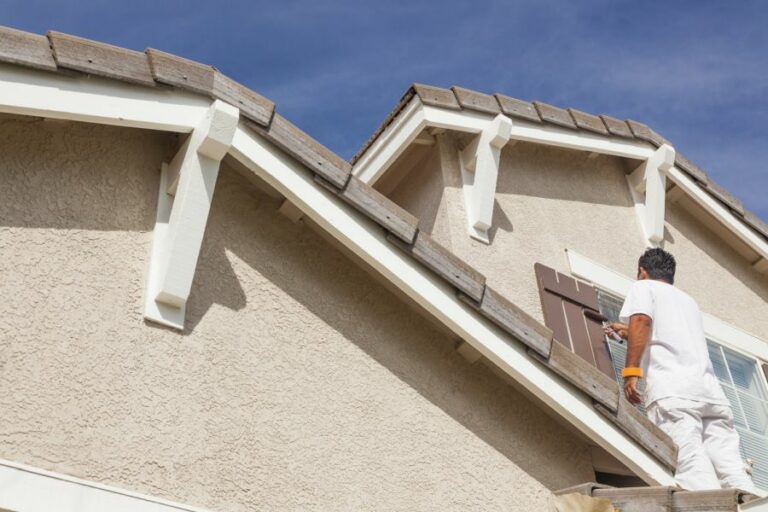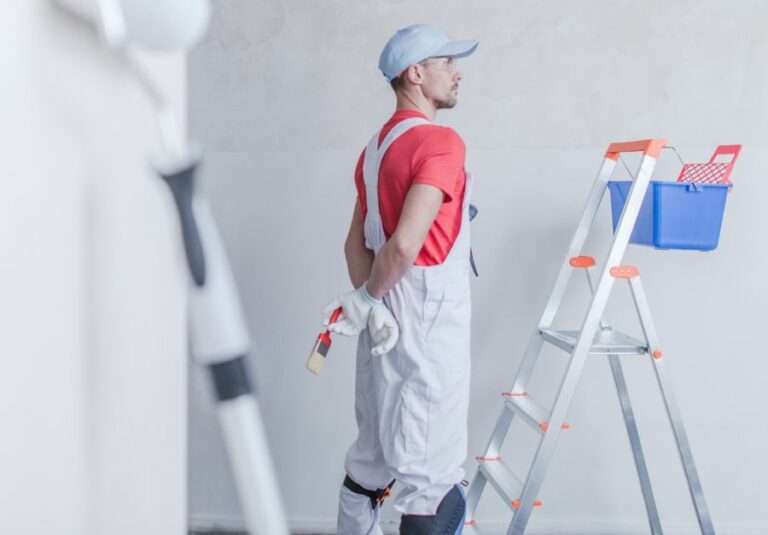Smooth Paint Essential Sanding Guide. What Pros Say
Are you tired of uneven paint finishes ruining the look of your DIY projects? Fear not, because we’re here to help you achieve that smooth, professional-looking paint job you’ve always dreamed of. In this essential guide, we will be discussing the importance of sanding and sharing some key techniques that will guarantee a flawless paint finish every time.
Smooth paint: essential sanding guide:
To achieve a smooth paint finish, follow this essential sanding guide: select the right sanding tools, such as hand sanding or power sanders, based on the project size; choose the appropriate sandpaper grit, starting with coarse and progressing to finer grits; and use proper sanding techniques, such as sanding in the direction of the wood grain, applying even pressure, and keeping a dust-free work environment. Remember to prioritize safety by wearing a mask and eye protection and working in well-ventilated spaces.

Tired of seeing uneven and blotchy paint on your walls and furniture? Read on to discover the secret to flawless finishes with our essential sanding guide. Master the art of smooth paint now!
Contents
- 1 Ultimate Sanding Guide for Smooth Paint Finishes
- 2 Choosing the Right Sandpaper Grit for Smooth Paint
- 3 Achieve a Smooth Paint Finish: Sanding Techniques
- 4 Preparing Surfaces: Ideal Smoothness for Painting
- 5 Determining the Necessary Amount of Sanding Before Painting
Ultimate Sanding Guide for Smooth Paint Finishes
• Introduction to Sanding
Sanding is a crucial step in preparing surfaces for a smooth paint finish. Proper sanding removes imperfections, such as bumps and scratches, resulting in a uniform surface that allows for better paint adhesion. In fact, improper sanding can lead to paint issues like peeling, flaking, and uneven coverage.
• Selecting the Right Sanding Tools
– Hand Sanding
For small projects and detailed work, hand sanding is both effective and affordable. When hand sanding, you can use a sanding block, a simple piece of wood, or just your hand wrapped with sandpaper.
However, using a sanding block is recommended because it provides even pressure distribution and minimizes sanding irregularities.
– Power Sanders
For larger surfaces and projects, power sanders are more efficient and save considerable time. There are several types of power sanders to choose from, including orbital sanders, random orbital sanders, and belt sanders.
- Orbital Sanders: These sanders move in a circular motion, making them suitable for light sanding tasks and finishing work. Orbital sanders are easy to control and can be used with one hand.
- Random Orbital Sanders: Similar to orbital sanders, random orbital sanders also move in a circular motion but with added random movement. This reduces the chance of sanding marks and streaks, making them ideal for intermediate and finish sanding. Belt Sanders: Best used for heavy sanding and removing large amounts of material, belt sanders are more aggressive and require both hands to control.
It’s essential to choose the right sander for the task at hand, taking into consideration the size of the project and the level of material removal required.
• Choosing the Proper Sandpaper Grit
Sandpaper grit is determined by the number of abrasive particles per square inch on the sandpaper. The higher the grit number, the finer and smoother the sanding results.
Sanding typically starts with coarse grit and progresses to finer grits for smooth finishing. Here’s a brief guide on which grit to use for different stages of the sanding process:
- Coarse (40 to 60 grit): Ideal for removing paint, varnish, and heavy material
- Medium (80 to 120 grit): Suitable for smoothing rough surfaces and leveling wood
- Fine (150 to 180 grit): Used for finish sanding and preparing surfaces for paint
- Very Fine (220 to 320 grit): Perfect for between-coat sanding and achieving a smooth final finish
Remember to progressively move to finer grits as you sand to ensure an even, smooth surface.
• Proper Sanding Technique
– Direction and Pressure
Always sand in the direction of the grain when working with wood, as sanding across the grain can cause scratches that become more visible after painting. On other surfaces, follow the contour or pattern to prevent sanding marks.
Apply firm but even pressure when sanding, particularly when using power sanders. Too much pressure can lead to gouges and inconsistent results, while too little pressure prolongs the sanding process.
– Sanding through Grit Progressions
Sanding through progressively finer grits is essential for a smooth, even finish. Start with a coarse grit to remove paint or level rough surfaces quickly, then switch to a medium-grit sandpaper to smooth out any remaining imperfections.
Finally, use fine-grit sandpaper to achieve a silky smooth finish. Remember to thoroughly clean the surface between grit changes to prevent cross-contamination and scratching.
– Dust Control
Maintaining a dust-free work environment is crucial for a smooth paint application. Regularly clean your sandpaper and sanding area to avoid buildup, which can lead to an uneven finish. Utilize a sanding block or power sander with a vacuum attachment to capture dust and streamline the cleaning process.
• Safety Tips and Recommendations
- Wear a mask with proper filtration to protect against fine dust particles
- Utilize eye protection to prevent debris from entering the eyes
- Use a well-ventilated workspace or utilize dust extraction when possible
- Take breaks when using power sanders to prevent hand and arm fatigue
• Final Thoughts
Sanding is an essential component of achieving a flawless paint finish and selecting the right tools, grit, and technique is crucial for success. Proper sanding removes surface imperfections, enables better paint adhesion, and leads to a professional-quality result.
By following our essential guide, you too can achieve a smooth and even paint finish for your next project.
Choosing the Right Sandpaper Grit for Smooth Paint
When it comes to smoothing paint, one of the essential tools is sandpaper. Understanding the correct grit of sandpaper to use is essential to achieve the desired result.
• Understanding Sandpaper Grits
Sandpaper grit refers to the number of abrasive particles per inch of sandpaper. The lower the grit number, the coarser the sandpaper, and the more aggressive it is at removing material.
As the grit number increases, the sandpaper becomes finer, providing a smoother finish on the surface.
– Coarse Grit (40-80 Grit)
Coarse grit sandpaper is primarily used for removing material quickly. This range of sandpaper is generally not suitable for smoothing paint as it can cause damage to the surface.
– Medium Grit (100-150 Grit)
Medium grit sandpapers are ideal for general-purpose sanding and removing minor imperfections. They are suitable for smoothing paint surfaces with rough textures or removing old paint layers.
– Fine Grit (180-240 Grit)
Fine grit sandpapers are perfect for smoothing paint surfaces that have already been sanded with coarser grits or have minimal imperfections. They provide an excellent finish and can be used for final sanding before painting or between coats.
– Very Fine Grit (280-400 Grit)
Very fine grit sandpapers are usually used to create an ultra-smooth finish on the surface. These sandpapers are best suited for sanding between paint coats or for final sanding before applying a clear coat or varnish.
– Extra Fine to Super Fine Grit (600-2000 Grit)
Extra fine to super fine grit sandpapers are not typically used for smoothing paint surfaces due to their ultrafine nature. These grits are more suited for tasks such as polishing and buffing on surfaces other than paint.
• Choosing the Right Grit Sandpaper for Your Paint Project
– Assess Your Paint Surface
Before selecting the appropriate grit of sandpaper, it is essential to assess the paint surface you are working on. Look for imperfections such as runs, drips, or rough textures that need sanding. Also, consider how many layers of paint are present.
– Smoothing a Rough Paint Surface
If you are working with a painted surface that has significant imperfections or requires the removal of old paint, start with medium grit sandpaper (100-150 grit). T
his grit will help remove material quickly while minimizing the risk of damaging the surface. Once the majority of imperfections have been removed, switch to a fine grit sandpaper (180-240 grit) to achieve a smoother finish.
I recommend doing a wet sanding technique with fine grit sandpaper to minimize dust and create an even smoother surface. Be sure to allow the surface to dry thoroughly before proceeding with painting.
– Sanding Between Paint Coats
Sanding between paint coats is essential for a smooth and professional finish. After the first coat of paint has dried, use fine grit sandpaper (180-240 grit) to smooth any imperfections or dust nibs that may have occurred during painting.
Be sure to clean the surface with a tack cloth before applying subsequent coats of paint.
For more delicate paint finishes, such as metallic or gloss, use very fine grit sandpaper (280-400 grit) for sanding between coats. This will create an ultra-smooth surface while minimizing the risk of removing too much paint.
– Final Preparation Before Clear Coating
If you plan to apply a clear coat or varnish, it is essential to create an ultra-smooth surface to achieve a flawless finish. In this case, use very fine grit sandpaper (280-400 grit) for final sanding after the paint layers have dried.
• Conclusion
Selecting the appropriate grit sandpaper for smoothing paint is critical for achieving professional-looking results.
Assess the paint surface, decide on the type of finish you desire, and choose sandpaper grit based on the recommendations provided in this article. With proper preparation and attention to detail, you can achieve a flawless finish on your paint project.
Achieve a Smooth Paint Finish: Sanding Techniques
A smooth paint finish not only looks aesthetically appealing but also prevents the paint from chipping easily. To achieve this, sanding is an essential step in preparing a surface for painting.
• Importance of Sanding Paint
As a professional painter, I can’t stress enough the significance of sanding paint. Sanding the existing paint helps in the following aspects:
- Creating a smooth finish: Abrasives in the sandpaper even out the surfaces, thereby contributing to a smooth paint finish.
- Adhesion: Sanding facilitates better adhesion of the new paint layers to the surface, ensuring long-lasting results.
- Removing imperfections: The process helps eliminate minor surface imperfections, such as scratches or blemishes.
• Steps to Sand Paint for a Smooth Finish
1. Choose the Right Sandpaper Grit
Choosing the appropriate sandpaper grit size is essential for an effective sanding job. Grit numbers range from 60 (coarse) to 3,000 (ultra-fine), based on the size of the abrasive particles on the paper.
- For initial sanding, I recommend using medium-grit sandpaper (100-150 grit).
- For final sanding, opt for fine or ultra-fine sandpaper (180-320 grit).
For more information about choosing the right sandpaper, visit this helpful guide from EngineeringToolBox.com.
2. Prepare the Surface
Before you begin sanding, clean the surface to remove dirt, dust, and grease. You can use a detergent solution and a clean cloth to wipe the surface and then rinse with water. Allow the surface to dry completely before moving on to the next step.
3. Protect Yourself and the Area
Take necessary safety precautions, such as wearing a dust mask, goggles, and gloves, to avoid inhaling dust particles or irritating the skin. Cover nearby furniture, flooring, and other items with drop cloths or plastic sheets to keep them clean during the sanding process.
4. Sand the Paint
Start sanding with medium-grit sandpaper in the direction of the wood grain or paint strokes. Apply even pressure, and avoid pressing too hard to prevent gouging the surface.
Note: For uneven surfaces or hard-to-reach areas, use a sanding block or sponge to ensure consistent sanding results.
When you have sanded the entire surface, check for scratches or remaining rough spots. If needed, switch to a finer grit sandpaper to smooth them out further.
5. Check the Smoothness
Feeling the surface with your hand is the best way to determine if the paint is smooth enough. Close your eyes and gently run your fingertips over the sanded paint. If you detect any rough spots, use a finer grit sandpaper to address them.
6. Clean Up
After you achieve the desired smoothness, thoroughly clean the surface to remove dust and debris from sanding. Use a vacuum cleaner or tack cloth to eliminate any remaining residue.
7. Prime and Paint
Once the surface is free of dust, I recommend applying a quality primer, followed by your chosen paint, to achieve a durable and smooth finish. Follow the manufacturer’s instructions for optimal results.
• Tips for Sanding Paint
- Be patient: Sanding can be a laborious process, but taking the time to do it properly is worth the effort when you see the end result.
- Work in a well-ventilated area: Adequate ventilation reduces the risk of inhaling paint dust or fumes.
- Keep sandpaper clean: Occasionally, clean the sandpaper while working by tapping it on a hard surface or using a brush to remove any build-up. Dirty sandpaper can scratch the surface rather than smooth it.
In conclusion, sanding paint is an essential step for obtaining a smooth paint finish. Follow the steps and recommendations provided in this article for best results. With patience and proper technique, you’ll achieve a professional and lasting finish on your painted surfaces.
How do you sand paint for smooth finish?
Step | Description |
|---|---|
1 | Wait for the paint to dry completely, typically 24-48 hours. |
2 | Choose an appropriate fine-grit sandpaper, such as 220 or 320-grit. |
3 | Attach the sandpaper to a sanding block or use folded sandpaper for better control. |
4 | Start sanding the painted surface with light pressure, moving in gentle circular or back-and-forth motions. |
5 | Periodically, wipe the surface with a cloth to remove dust and check your progress. |
6 | If needed, repeat the sanding process with a higher grit sandpaper for a smoother finish. |
7 | Once the desired smoothness is achieved, clean the surface thoroughly to remove any remaining dust. |
8 | Apply a finishing coat of paint, polyurethane, or other protective sealant, if desired. |
Preparing Surfaces: Ideal Smoothness for Painting
Proper surface preparation is crucial to achieve a smooth and professional-looking paint job. One critical step in this process is sanding.
• The Importance of Sanding Before Painting
Sanding before painting is essential for several reasons, which include:
- Removing surface imperfections: Sanding helps to eliminate scratches, dents, and other surface irregularities that may be visible through the paint.
- Creating surface adhesion: Sanding generates tiny scratches on the surface, allowing the paint to adhere more efficiently.
- Promoting even paint distribution: A properly sanded surface ensures that the paint will be applied consistently, improving the final appearance.
• Determining the Right Level of Sanding
There isn’t a universal answer to the question, “How smooth should you sand before painting?”. The appropriate level of sanding depends on various factors, such as:
– Wood Condition
The condition of the wood is a significant determining factor in how smooth you should sand it before painting. If the wood is rough, full of knots, or damaged, it will require a more aggressive sanding process.
In contrast, if the wood surface is already smooth, only a light sanding might be needed. For example, you may use 60-grit sandpaper for rough surfaces and 120-grit sandpaper for smoother surfaces.
– Paint Type
Oil-based paints tend to show imperfections more prominently than water-based or latex paints. When using oil-based paint, it is essential to sand the surface smoothly to achieve a professional finish.
However, for water-based or latex paints, you can get away with a less smooth surface preparation since these paints are more forgiving of minor imperfections.
– Desired Finish
If you desire an ultra-smooth, showroom-quality finish, you must sand the surface extensively. In general, the more polished the finish, the smoother the surface should be. However, if you’re going for a more rustic or textured look, less sanding may be acceptable.
– Tool Marks
If you’ve used power tools to shape, cut, or prepare the surface, there’s a chance that tool marks will be left behind. These marks can cause uneven paint absorption and should be removed through sanding before painting.
• Sanding Process and Techniques
– Start with Coarser Sandpaper and Work Your Way to Finer Grits
To achieve the ideal smoothness before painting, start with coarser grit sandpaper (e.g., 60 – 80 grit) and move up to finer grit sandpaper (e.g., 150 – 220 grit) in stages. Sanding in progression will remove surface imperfections efficiently and produce a smooth surface.
– Use a Sanding Block
Using a sanding block prevents uneven sanding pressure and ensures a more consistent finish. You should apply firm pressure without being overly aggressive, as this may create new scratches or dents in the surface.
– Sand in the Direction of the Wood Grain
Always sand with the wood grain, rather than against it. Sanding against the grain can cause tearing or gouging in the wood fibers, leading to a rough surface. Sanding with the grain minimizes the risk of this happening.
– Remove Dust between Grits
Before switching to a finer grit sandpaper, make sure to remove dust from the surface either by wiping it with a cloth or using an air compressor. This step prevents dust from clogging the sandpaper and affecting the sanding process.
– Check Your Progress
Periodically check your progress by running your hand over the surface to feel for any remaining imperfections. Additionally, you can use a bright light at a low angle to visually inspect the surface for scratches or other issues.
• Final Thoughts
In conclusion, the smoothness of the surface before painting will depend on various factors such as wood condition, paint type, and desired finish.
In general, you should sand the surface progressively from coarser to finer grit sandpapers until the desired smoothness is achieved. Proper sanding techniques are crucial in attaining that flawless finish to your paint job.
Determining the Necessary Amount of Sanding Before Painting
Proper preparation is key to achieving a professional-looking paint job, and sanding is an essential part of that process.
• The Importance of Sanding Before Painting
Sanding serves several essential purposes in the painting process:
- Removing Imperfections: Sanding removes any surface imperfections, such as scratches, gouges, or rough spots on the surface you are preparing to paint. This results in a smooth, even surface that allows for a flawless and professional-looking paint job.
- Creating Surface Adhesion: Paint adheres better to a slightly roughened surface. Sanding lightly scuffs the surface, allowing the paint to bond more effectively with the substrate material.
- Promoting Even Absorption: Sanded surfaces help ensure even paint absorption. This prevents blotchiness or uneven paint coverage and contributes to a uniform appearance across the entire painted surface.
• Determining the Correct Sandpaper Grit
Before you start sanding, it’s essential to select the appropriate sandpaper grit for your project. Sandpaper is available in a range of grits, from coarse (around 40-grit) to fine (around 600-grit or higher). The grit you choose will depend on the condition of the surface you are preparing to paint and the type of paint you will be using.
- For surfaces with significant imperfections, begin with a coarser grit (60-80 grit) to remove the bulk of the material quickly.
- For surfaces with minor imperfections or those that simply need light scuffing, a medium grit (120-150 grit) is suitable.
- For surfaces that are already mostly smooth and well-prepared, a fine grit (180-220 grit) can be used for the final sanding pass.
Tip: Use a sanding sponge or sandpaper holder for an easier and more comfortable grip when sanding.
• Evaluating the Surface Condition
The amount of sanding needed before painting will depend on the condition of the surface being painted. Here are some common scenarios and recommendations:
– New, Unpainted Surfaces
For new, unpainted surfaces, minimal sanding is required. A light sanding pass with fine-grit sandpaper (180-220 grit) is sufficient to create surface adhesion and remove any minor imperfections before painting.
– Previously Painted Surfaces in Good Condition
If the previous paint job is in good condition (i.e., there are no peeling, cracked, or flaking areas), only light sanding is needed to promote good paint adhesion. Use fine-grit sandpaper (180-220 grit) to scuff the surface evenly and remove any gloss.
– Previously Painted Surfaces with Peeling, Cracking, or Flaking
In this scenario, more extensive sanding will be needed to remove the damaged paint and create a smooth surface for the new paint job.
Begin with a coarser grit (80-100 grit) to remove the damaged paint, then work your way progressively through medium (120-150 grit) and fine grit (180-220 grit) sandpapers to smooth the surface.
– Surfaces with Multiple Layers of Paint
When dealing with surfaces with multiple layers of paint, it’s important to remove any loose, flaking, or peeling layers before sanding. Use a paint scraper, heat gun, or chemical paint stripper to remove these layers.
Once the surface is clean and stable, sand with medium-grit (120-150 grit) sandpaper, followed by a final pass with fine-grit (180-220 grit) sandpaper to smooth the surface.
• Final Inspection and Cleaning
Once you have finished sanding, it’s essential to inspect the surface carefully to ensure that all imperfections have been removed and that the surface is suitably prepared for painting. Run your hand over the surface to feel for any rough spots and address them with additional sanding if necessary.
Finally, clean the surface thoroughly to remove any dust or debris created during the sanding process. Use a tack cloth, vacuum, or microfiber cloth to ensure the surface is completely clean before proceeding with painting.
• Summary
In conclusion, the amount of sanding needed before painting depends on the condition of the surface and the desired end result. Always select the appropriate sandpaper grit for your project, and work systematically from coarse to fine grits to create a smooth, well-prepared surface.
Proper sanding is critical to achieving a professional-looking paint job, so take the time to complete this stage of the painting process thoroughly and diligently.
Surface Type | Level of Sanding | Recommended Grit |
|---|---|---|
Previously Painted Surface | Light Sanding | 180-220 grit |
Bare Wood | Medium Sanding | 120-150 grit |
Previously Varnished Surface | Heavy Sanding | 80-100 grit |
Uneven Surface | Medium to Heavy Sanding | 100-150 grit |
Metal Surface | Varies (Rust removal, if necessary) | 80-220 grit, depending on the condition |







